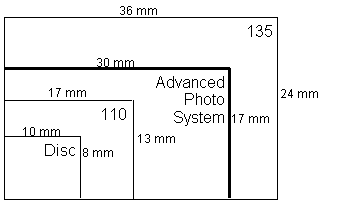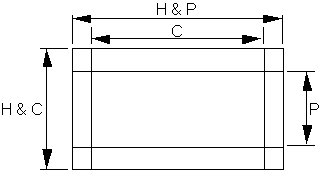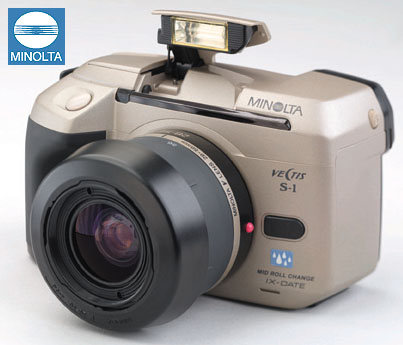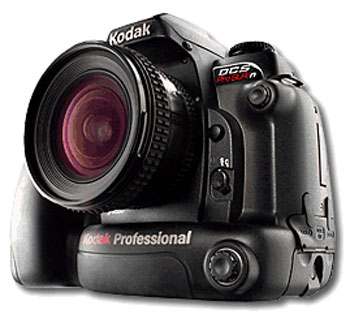The Digital Sensor: A Guide to Understanding Digital Cameras
by Wesley Fink on April 21, 2008 1:00 AM EST- Posted in
- Digital Camera
Why All these Different Sensor Sizes?
35mm first appeared on the scene in the 1930s and the film format simply took 35mm motion picture film and spooled it into a light-tight canister. By the 1960s, with point-and-shoot and developments in SLR technology, 35mm had become king of the film formats. Even as film manufacturers tried to introduce other film formats, 35mm continued to grow and prosper.
The SLR evolved in 35mm space and the world appeared orderly on the surface, but the only real constant was the size of the film. It was 35mm, but SLR manufacturers each championed their own lens mount and their exclusive lens line for their SLR film cameras. The primary advantage of the SLR was the ability to look through a wide variety of interchangeable lenses, and to accurately focus, meter, and later auto-focus through the viewing lens. As in today's digital SLR market, each manufacturer had their own lens mount, and lenses developed for one mount would not fit and work on others, i.e. a Nikon lens would not fit or work on a Canon camera.
APS (Advanced Photo System)
With the very early developments in digital photography, Kodak, Fuji, and others saw the handwriting on the wall for film photography. One of the ongoing complaints about 35mm film, however, has been that the 2:3 image format required image loss in almost every standard print size. Neither 8x10 nor 5x7 is a 2:3 ratio and both required cropping of the 35mm negative.

In 1996 a new APS (Advanced Photo System) initiative by Kodak, Fujifilm, Minolta, Nikon, Canon, and others was introduced to save film by standardizing on new ratios and adding new "computer-like" data storage capabilities in the taking and processing of film images. APS included a new film size - 30.2mm x 16.7mm - that could be printed full-frame (H or HDTV format), or use standard crops of 25.1mm x 16.7mm (C or Classic 2:3 format) or 9.5mm x 30.2mm (P or Panorama). Actually, the image size that was always shot was the 30.2mm x 16.7mm, and the other sizes were just standard crops.

The industry was confident they could sell APS, which in the most common C view was only about 55% of the already small 35mm size. Some manufacturers like Minolta developed new APS lens lines with smaller cameras and lenses, and Canon and Nikon developed APS camera bodies that could mount their regular lenses - and a few custom APS lenses.

In the end, APS failed in the film market. Industry pundits generally say APS failed because the negative was just too small, but it is more likely that it failed because it was just too late. Digital was on the near horizon, and many photographers did embrace smaller digital sensors while they rejected the smaller APS film format.
APS film is not that important in our discussion of digital photography, but the APS standard is important because it was also a standard for digital development. At the time of the APS initiatives, it seemed reasonable to aim for development of digital sensors for that same APS format, so lenses for both systems were interchangeable.
Most in the industry aimed for the APS C size sensor, which would be about 16.7mm x 25.1mm - the same ratio (2:3) as the classic 35mm format. Most manufacturers, burned by bad decisions in the APS film debacle, decided to keep their existing 35mm mounts, so their existing 35mm lenses could be used. They hedged their bets. This pleased current 35mm system owners, and camera makers could see if the new digital SLRs took hold. Once they were satisfied there was a market for digital SLR cameras, they could develop new lenses with a smaller image circle.

Canon and Nikon worked with Kodak in the early digital years to use their best film bodies with the current state-of-the-art Kodak sensors. These early DSLR cameras were incredibly expensive with massive power requirements and pro only. This development line culminated in the full-frame Kodak DCS Pro SLR/n and SLR/c. Those two cameras were the end of Kodak digital SLR cameras, although the company is still very active in the development and manufacture of digital imaging sensors and compact digital cameras.
Camera manufacturers introduced digital SLR products that revolved around the strength of their SLR business, the sensor capabilities they brought to manufacturing, and the relationships they had with other sensor manufacturers. Most of today's consumer DSLR cameras are based on sensors approximately APS C size, but they vary from the Olympus 4/3 sensor at 225mm² to the full-frame 35mm size with an area of 864mm².
Discussion of sensor size always tends to generate passionate discussion of the advantages of one manufacturer's sensor format over others, but please keep sensor sizes in perspective. The smallest 4/3 sensor still has 5.2x greater sensor area than the 43mm² sensor used in the 12MP Canon G9. The 4/3 sensor is 9x greater area than the common 1/2.5" compact sensor with an area of 25mm². Differences in digital SLR sensor size do matter, but they are very small compared to the difference in area between compact point and shoot digital sensors and today's digital SLR camera sensors.










72 Comments
View All Comments
Johnmcl7 - Monday, April 21, 2008 - link
I do agree with you there that it is desirable to have deeper depth of field (particularly on macro) but I think the difference is that on an SLR you have the choice - you can shoot wide open and have shallow depth of field or you can stop down (and normally have to use up the ISO advantage) to get depth of field. On a camera with a small sensor you are generally stuck with the deep depth of field whether you want it or not.John
finbarqs - Monday, April 21, 2008 - link
I hope nobody is using F/1.2 when shooting a portrait. Unless you want only a nose to be in focus. With something THAT shallow, you either have to REALLY step back and use distance to your advantage to get what you want in Focus. Professional Wedding photographers will not TOUCH anything above f/5.6 as you don't want to get ONLY the bride in focus while the groom is OOF.People, remember there are multiple factors that affect DOF. Aperture is definitely one of them, distance, and Focal Length.
Obviously you want something very shallow with great bokeh, then you would get close to your subject, open up your aperture, and have a telephoto focal length.
The thing is, on a FF sensor, you "see more" on the same focal length as a cropped sensor. Well put wesley, a 50mm is a 50mm. For those of us with cropped sensors, slap a 50mm on your camera. (or zoom to 50mm). Look at your subject with your naked eye, then look through the view finder. SAME SIZE AND SHAPE! Nothing gets larger! Supposedly a telephoto range (greater than normal) should have some zoom effets shouldn't it? I mean APS-C sensors are either 1.5 or 1.6 smaller than a full frame, that means the normal focal length should be around 27mm? So 50mm should be 75mm for nikons and 80mm for canons! That means you should see some zoom in 50mm! but nope! you don't! in fact, the only time you'll see the zoom is AFTER you fire the shutter and it displays the image to fill that 2.5" or 3.0" inch lcd you have! (or even 2.0") So where does the FF excel? you place 2 cameras exactly side by side of each other, same focal length, same focus point. Same lens. Through the Viewfinder, you'll see the nice Bokeh of your subject on BOTH cameras, exactly the same. Difference? the FF has more frame coverage! Thus, having better "DOF" (or lack thereof) because of the more frame coverage! On this note, let's all by Hasselblad's Medium FF and get some nice digital backs! ;)
haplo602 - Tuesday, April 22, 2008 - link
Hmm ... In my understanding the difference in FF to APS-C is CROP.A 50mm lens on APS-C has the same DOF, same perspective characteristic as on a FF camera, but the sensor is smaller, so you basicaly get a CROP of the original FF image. There is only a perceived zoom effect as the image is a smaller area.
For Nikon you get 1.5x smaller image area, but everything else is the same as on FF.
melgross - Tuesday, April 22, 2008 - link
It has to do with distance from the subject as well. Perspective is the ratio of the distance to the subject to the distance to the background.So, to get the same size on sensor, with the same lens length, you must either move closer, or further, changing the perspective, and the depth of field.
finbarqs - Monday, April 21, 2008 - link
Medium Format* sorry, typo :)Johnmcl7 - Monday, April 21, 2008 - link
Other way round - a larger sensor gives you *less* depth of field which as you quite rightly point out is a strong advantage of a larger sensor.John
pinto4402 - Monday, April 21, 2008 - link
DOF is also a function of the lens. Some ultra-serious photographers are willing to pay $2500 for a Canon 85mm 1.2L over a 85mm 1.8 (which is just as sharp and which only retails for $300), because the 1.2L has a softer, more pleasing DOF effect.TETRONG - Monday, April 21, 2008 - link
Cool article.Looking to buy a camera pretty soon here.
What do you folks think about the G9?
Is there a particular brand I should favor?
Also, are there any cameras available that do "tricky" stuff, like Infrared, Macro, or that neat effect when cities look miniature? (Can't find an example)
I read an article about a guy a few years back that would setup a scene, then he would walk around selectively lighting certain aspects in trippy ways to make a final composite image.
Anyone know what this is called, or where I can learn more about it?
Much obliged!
strikeback03 - Tuesday, April 22, 2008 - link
Is "fisheye" what you are looking for for the miniature cities?and the selective lighting is often called "Painting with light"
plenty of compact cameras can do OK macro if you can get really close to your subject, but as this is often hard for reasons of lighting and/or scaring off the subject, an SLR with a real macro lens is still beneficial.
pinto4402 - Monday, April 21, 2008 - link
There was an article at http://www.popphoto.com/popularphotographyfeatures...">http://www.popphoto.com/popularphotogra.../4923/th...about infrared photography. It also discusses a company that is modifying certain digital cameras for infrared use.